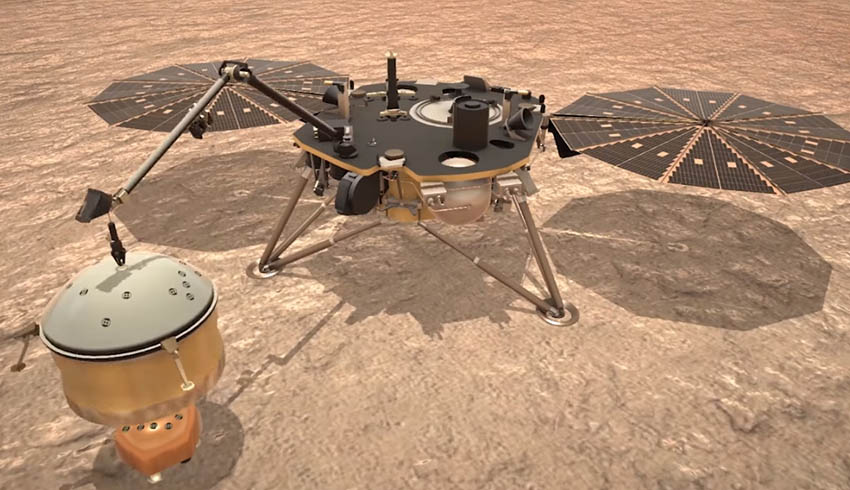
According to three papers published on Friday, nearly three years after landing on Mars, the InSight spacecraft and its seismometer instruments have successfully revealed the makeup of Mars' inner composition.
According to the papers, Mars' composition is similar to that of Earth, with the planet boasting a crust, mantle and core.
In fact, scientists now know that at the centre of the planet, Mars has, like Earth, a molten core. However, while Earth has a molten outer core and solid inner core, scientists will need to continue to look into InSight's data to determine if the same is true for Mars.
“When we first started putting together the concept of the mission more than a decade ago, the information in these papers is what we hoped to get at the end,” said InSight’s principal investigator Bruce Banerdt of NASA’s Jet Propulsion Laboratory in Southern California, which leads the mission.
“This represents the culmination of all the work and worry over the past decade.”
NASA said in a statement, "Like Earth, Mars heated up as it formed from the dust and larger clumps of meteoritic material orbiting the sun that helped to shape our early solar system."
Over the planet's first tens of millions of years, Mars, again like Earth, separated into three distinct layers – the crust, the mantle, and the core.
Essentially, InSight was tasked with measuring the depth, size, and structure of each of these three layers.
InSight's seismometer called the Seismic Experiment for Interior Structure (SEIS), has to date recorded 733 distinct 'mars-quakes', 35 of which were between magnitudes 3.0 and 4.0, all of which were used to prepare the three published papers.
Seismic waves vary in speed and shape when travelling through different materials inside a planet, so recording such events allows scientists to learn more about the inner structure of the planet.
Through this information, NASA has been able to extrapolate that Mars's crust is actually thinner than previously anticipated, at about 20 kilometres deep, however may have a second and even third sub-layer, that collectively penetrates 37 kilometres deep.
“Layering within the crust is something we see all the time on Earth,” said Brigitte Knapmeyer-Endrun of the University of Cologne, lead author on the paper about the crust. “A seismogram’s wiggles can reveal properties like a change in porosity or a more fractured layer.”
Beneath the crust is the mantle, which InSight suggests extends about 1,560 kilometres below the surface of Mars.
Mars' core, which is now confirmed as being molten, has a radius of about 1,830 kilometres, in a discovery that was hugely exciting for the InSight team.
“This study is a once-in-a-lifetime chance,” said Simon Stähler of the Swiss research university ETH Zurich, lead author of the core paper. “It took scientists hundreds of years to measure Earth’s core; after the Apollo missions, it took them 40 years to measure the moon’s core. InSight took just two years to measure Mars’ core.”
To date, most of the significant 'mars-quakes' recorded by InSight appear to have come from one area, a volcanically active region dubbed Cerberus Fossae.
Scientists believe that lava may have even flowed in this area within the last few million years, thanks to tracks of spotted by orbiting spacecraft.
"Curiously, no quakes have been detected from more prominent volcanic regions, like Tharsis, home to three of the biggest volcanoes on Mars," NASA said, however noted this could just be due to InSight not being able to detect such activity due to shadow zones.
While InSight's data has supplied a lot of new knowledge on Mars' makeup, scientists continue to wait for a quake of bigger magnitude, to better determine the inner workings of the Red Planet.
“We’d still love to see the big one,” said JPL’s Mark Panning, co-lead author of the paper on the crust. “We have to do lots of careful processing to pull the things we want from this data. Having a bigger event would make all of this easier.”

Hannah Dowling
Writer – Defence and Aerospace, Momentum Media
Hannah joined Momentum as a journalist in 2019, and has since written breaking news stories across a diverse range of corporate industries, including finance, real estate, investments and aviation. She has a keen interest in the global aviation sector, with a particualy focus on improving overall individual wellbeing across the aerospace industry.
Hannah graduated from Macquarie University in Sydney Australia with a Bachelor of Media (Journalism) and is currently pursuing postgraduate studies.
Send Hannah an email at [email protected] or connect via Twitter or LinkedIn.
Receive the latest developments and updates on Australia’s space industry direct to your inbox. Subscribe today to Space Connect here.









